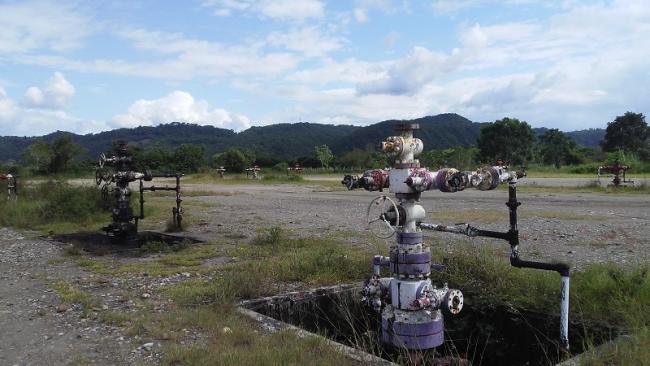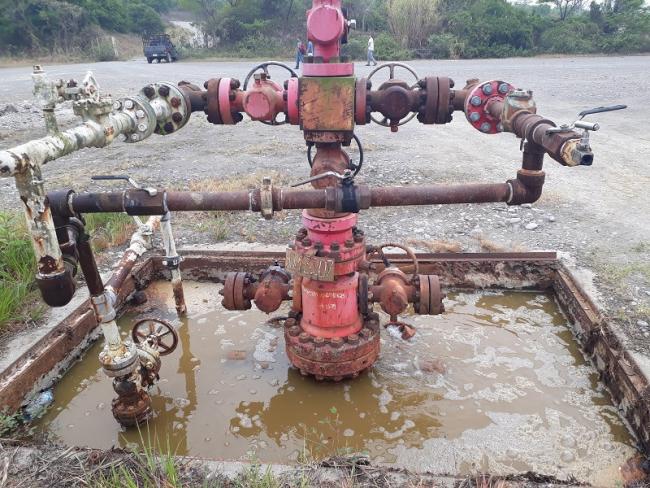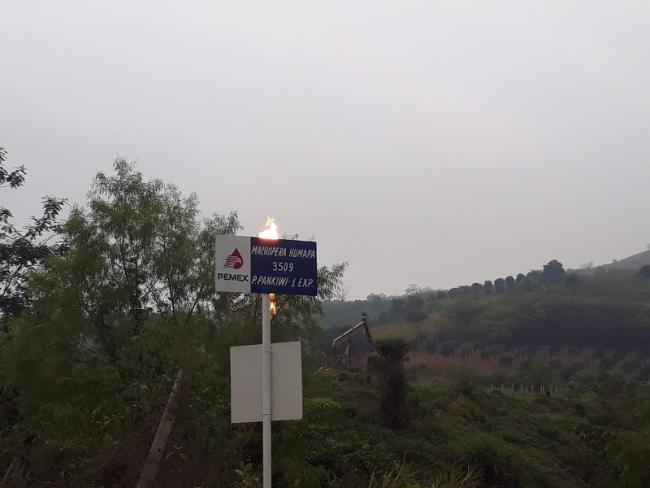
The Burgos Basin shale gas field, which spans the arid shrublands of Northern Tamaulipas, Mexico, is a potential bonanza as big or bigger than the record-setting Eagle Ford shale play across the Rio Grande in South Texas.
Yet the promised fracking boom in Mexico, hyped in U.S. media and pushed by the U.S. government, has yet to materialize. Local communities and environmental organizations want it to stay that way. Anti-fracking activists see a window of opportunity to push President Andrés Manuel López Obrador to put a fracking ban into law. They worry that if fracking does eventually pick up, before or after AMLO leaves office, it could drain and contaminate dwindling water resources.
After winning the 2018 presidential race, López Obrador announced that he would ban fracking. More than two years later AMLO has wavered and there is still no law on the books. Investors in the Mexican oil and gas sector have hesitated, waiting for administrative reforms and better economic conditions. The economic downturn, tied to the bust in oil prices and the coronavirus pandemic, have further discouraged investors this year.
Advocates hope that pushing the López Obrador government to put a fracking ban into law will stave off the eventual growth of the industry in Mexico. Meanwhile, gas companies hope for legislative clarity that would ensure the security of their investments. The two sides can agree on one thing: the potentially vast payoff of the Burgos play is too big to ignore forever.
An Untapped Bonanza
Hydraulic fracturing is the technique used to drill horizontally and create new fractures in the rock to extract oil and gas. While fracking is commonly associated with the use of this practice in shale deposits, Mexican agencies use the same term when wells are fracked to access conventional deposits of oil and gas, not only those embedded in shale rock.
In 2013, the U.S. Energy Information Administration placed Mexico at sixth worldwide with shale reserves of 545 trillion cubic feet, nearly as much as the United States’ estimated 665 trillion cubic feet. Yet seven years later, no one is sure how valuable the Burgos Basin reserves really are because they have been so lightly explored.
“What the U.S. government estimate of gas reserves is based on speculation,” says Gonzalo Hatch Kuri, a geographer at the National Autonomous University of Mexico who studies water resources. “We don’t know if it’s true and you can’t exploit gas based on an amount that’s not scientifically proven.”
The state-owned oil and gas company Pemex has used hydraulic fracturing and horizontal drilling since the 1980s. In 2013, Pemex announced its first successful shale gas test well in the Burgos Basin, where there are already 3,500 active conventional gas wells. But seven years later, shale gas wells remain at the exploratory stage. Pemex has drilled approximately 20 exploratory wells in the basin, but as of January 2020, there are still no private firms drilling for shale gas.
For now, challenges of infrastructure, investment, and regulation are leaving Mexico’s potentially massive shale deposits mostly untapped. “The market is dead right now. Fracking isn’t going forward,” says Hatch Kuri.
The situation north of the Rio Grande, meanwhile, has been different. Between 2009 and 2019, a fracking boom centered in Texas (along with North Dakota and Pennsylvania) propelled the United States to become the world leader in oil and gas production. The coronavirus pandemic has brought that boom to a screeching halt, but the infrastructure is in place for a resumption if the price of petroleum rises again.
The United States has promoted fracking around the world, through the Unconventional Gas Technical Engagement Program under Hillary Clinton’s State Department. Mexico, Colombia, and Chile were a few of the Latin American countries targeted in the program. The State Department organized a fracking regulatory workshop in late 2013 in Mexico City.
The 2014 Energy Reforms passed by Enrique Peña Nieto, which the U.S. government also quietly supported, were fundamental to attracting the foreign investment needed to jumpstart the fracking industry. While as a candidate López Obrador originally called for cancelling the reforms, he has softened his criticism since entering office. Yet with the coronavirus-induced economic downturn setting in, López Obrador has pushed for increased oil production to rebuild the economy, and once again floated the possibility of repealing the Energy Reforms.
Mexico depends on U.S. companies for fracking technology and know-how, so discouraging foreign investment in the energy sector would have the effect of slowing its development. But when asked about a possible ban, a spokesperson of Mexico’s Security, Energy and Environment Agency (ASEA) said, "At the moment there is not an explicit law with that objective."
Local Opposition Mounts
Activists working on water and environmental issues in Mexico say they have learned from the environmental devastation wrought by fracking in states like Pennsylvania, West Virginia, and Texas.
“The more we learned, we saw fracking was a very dangerous technique,” says Claudia Campero, a water campaigner with Food and Water Watch in Mexico. “It was a bad idea to expand it to Mexico.”
Campero is a founding member of the Mexican Alliance Against Fracking, which brings together dozens of national and local organizations. The Alliance has collected public records showing that 7,879 hydraulically fractured wells already exist in Mexico. But it is unclear how many are pumping shale gas. The Alliance includes members in Mexican states where fracking is already taking place, like Nuevo León, Puebla, and Veracruz.
While federal funding for fracking pales in comparison to what the private sector could leverage—and what would be necessary for Mexico to compete with gas producers like the United States—the Alliance says the verbal commitments of the López Obrador government are “not translating into actions.”
According to public records requests made by the Alliance and documented in a May 2020 report, the National Hydrocarbons Commission (CNH) published six plans for hydrocarbon exploration in unconventional deposits in Puebla and Veracruz during 2019. Meanwhile the Ministry of Energy (Sener) assigned 12 possible shale deposits to Pemex Exploration and Production (PEP), a Pemex subsidiary. PEP continues to receive federal funding for projects that require fracking.
Many of the hydraulic fracturing sites are where Pemex has pre-existing infrastructure. That is the case in Veracruz, where residents formed the Regional Coordinator of Solidarity Action in Defense of Huastecan-Totonacapan Territory (Corason) in 2015.

Alejandra Jiménez, of Papantla, Veracruz and a founder of Corason, says that Pemex did not inform communities when it began hydraulic fracturing in the region. “You would see the impacts, without knowing it was due to fracking,” she says. “A lot of houses had cracks.”
In nearby El Tablón, Puebla, people noticed a foul smell in March 2019. Fifty people in the town developed headaches and nausea due to the fumes in March and April 2019. They later learned that fracking was taking place less than a kilometer from town at the Pankiwi well, operated by Pemex.
Residents sought an explanation for the smells and mysterious health impacts in 2019. “We denounced the situation publicly,” says El Tablón resident Guadalupe Pérez Rodríguez, referring to a complaint to the National Human Rights Commission. “But [the companies] haven’t informed us what is going on.”
“We have a freshwater spring in the community, and we don’t want it to be contaminated,” says Pérez Rodríguez. “The companies extract, extract, extract, but they don’t give anything back.”
A representative of ASEA did not comment directly on the reports of health hazards in El Tablón and instead referred to federal guidelines for mitigation and risk management for non-conventional energy sources.
Similar impacts have been observed in other states. Civil engineer Juan Manuel Rodríguez Martínez of the Autonomous University of Nuevo León has documented an increase in earthquakes as fracking began in a region that does not normally have seismic activity. Also in Nuevo León, residents of the towns of China, Los Ramones, Anáhuac, and Melchor Ocampo have reported cracks in their homes and contaminated water after exploratory fracking wells were drilled nearby.

While regulators have issued guidelines for fracking in Mexico, lawmakers have not adopted a legal framework, according to Daniel Jacobo-Marín, an environmental lawyer in San Luis Potosí who works with communities in areas where shale gas deposits have been identified.
“The way the guidelines are written, they jeopardize the rights of communities,” says Marín. He explains that Article 416 of the Federal Penal Code prohibits discharging contaminated wastewater above or belowground. He says the guidelines for fracking represent a “serious contraction” of Article 416.
The 2014 Energy Reforms were “passed so quickly that other laws about water rights were totally run over,” asserts Marín.
The ASEA spokesperson said that the guidelines do protect aquifers and prohibit subterranean chemical filtration.
Replicating U.S. Fracking Boom Is Not Easy
The lack of regulatory clarify has also deterred investors, according to Matthew Fry, a geographer at the University of North Texas. He says investors have also remained hesitant due to the high cost of building the infrastructure needed for fracking.
Outside the United States, Argentina is the only country in the Americas to have seen a fracking boom, after rolling back regulations and incentivizing foreign investment, according to Fry. Communities in Mexico also have more say over their mineral rights than in Texas, so companies must work at the local level to secure permission to drill, he says.
“It's quite a bit more expensive to drill in Mexico compared to what they could pipe in from Texas,” says Fry. “What happened with shale and the massive boom in the U.S. was really unique, and we haven’t seen it duplicated anywhere else.”
Some observers say that sooner or later, the country’s apparently vast shale deposits will be tapped. “Supply of natural gas is a concern that must be addressed,” says Adrián Duhalt, a postdoctoral fellow in Mexico energy studies at Rice University's Baker Institute. “The sensible thing to do is to start evaluating the possibility to develop shale gas resources.”
“As Mexico dips into a recession, President López Obrador's nationalistic stance on energy issues could prevent a faster economic recovery,” says Duhalt.
While the outlook for fracking in Mexico may be mixed, communities remain alert to the risks. “We hope that the crisis in hydrocarbons helps us,” Corason’s Jiménez says. “We don’t want these resources to be extracted in another form. We want them to stay in the soil.”
Pérez Rodríguez of Puebla is also dubious that the president will follow through on his word. “The president can say they banned fracking,” he says. “But it’s not like he’s going out and checking every well.”
Martha Pskowski is NACLA’s web editor and a master’s candidate in Latin American and Caribbean Studies and Journalism at NYU. She reports on environmental justice, labor, and agriculture.

